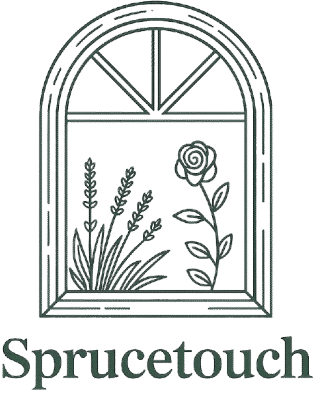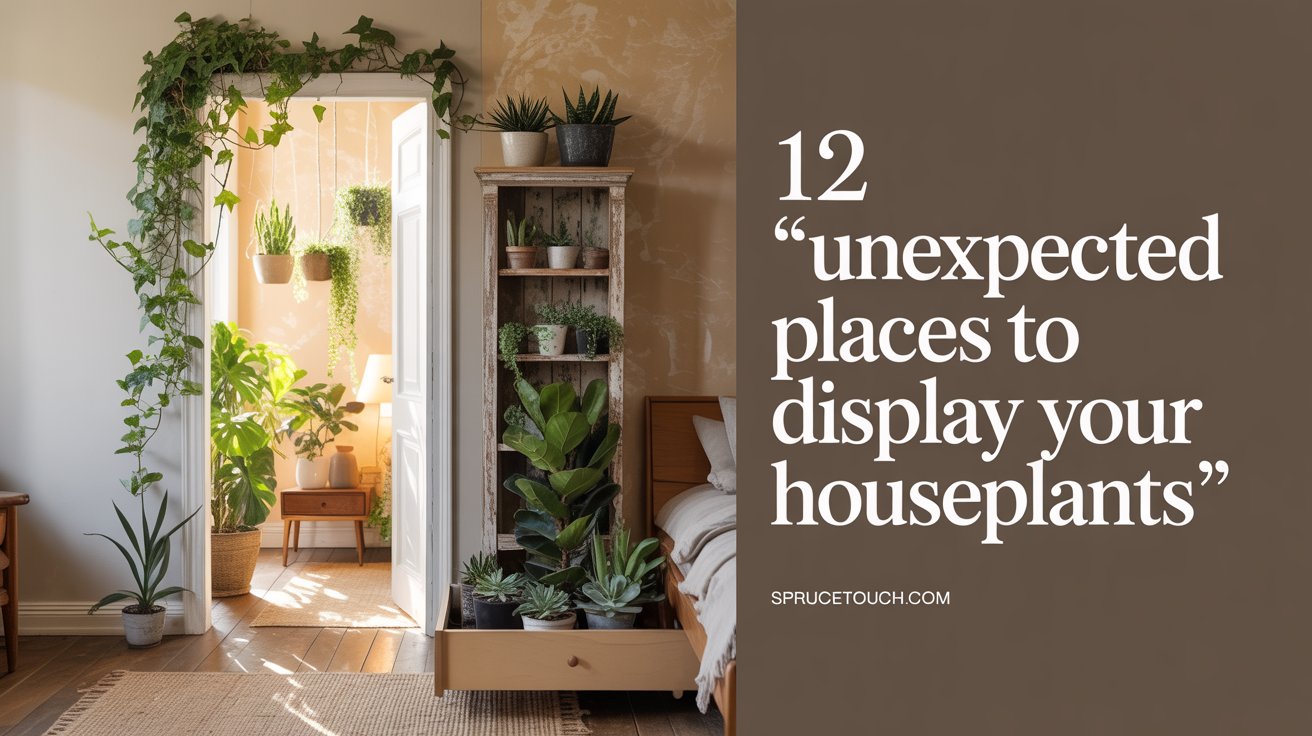You know the feeling: you’ve cleared the usual spots (windowsills, end tables, hanging baskets), yet your indoor jungle still needs room to breathe. Houseplants add so much life to a home—but sometimes it’s fun to think outside the pot (literally). In this post, I’m sharing 12 unexpected places to display your houseplants, with real-life tips and visual ideas you can actually bring into your space. Whether you live in a compact apartment or a full-sized home, you’ll find at least a few creative spots that surprise and delight. And yes—these are places I’ve personally tried (some with hilarious trial and error).
(If you want to brush up on potting mixes or picking plant containers first, you might enjoy our post on How to Choose the Right Pots for Your Indoor Plants.)
1. Above Kitchen Cabinets – “Green Crown in the Kitchen
If your kitchen has a gap between the top of your cabinets and the ceiling, that often-overlooked space can become a mini greenhouse perch. I love placing lightweight trailing plants here—think pothos or ivy—that can cascade a few inches down. Because that area is usually warm (especially near lighting), choose plants that tolerate mild heat and low light.
My tip: use shallow trays or saucers beneath the pots so any stray drips or soil dust don’t fall on your stove top or cabinets. I once placed a baby spider plant up there, and when it produced pups, they slowly slid down in charming tendrils. Be sure to anchor pots so they won’t shift if you open cabinet doors or bump into anything.
Also, don’t forget to gently dust the leaves now and then. When I first ignored this, the leaves looked dull under the warm cabinet lighting. Now I keep a feather duster handy. Over time, the top-of-cabinet display feels like a “crown” of green framing the room.
2. On Staircase Riser Shelves – “Step-by-Step Garden”
If your stair risers are open or have space behind them, consider turning them into little shelves for plants. I used this trick in my older home with open stairs—each step got a tiny plant or two. I liked alternating sizes: a small succulent one step, a fern the next, and so on.
One challenge is watering — you’ll want to use pots with extra catch trays or water carefully to prevent drips onto lower steps. I often water early in the morning and leave a towel on the lower stair just in case. Also, ensure the pots are stable—especially if kids or pets are around.
The result is so whimsical: as you walk up or down, your steps feel like a slow reveal of greenery. I once hosted guests who didn’t notice it until the third step, and then they’d say, “Oh wow, did you do all that yourself?” It’s subtle but gives your home personality.
3. Inside a Bookshelf Alcove – “Botanical Book Nook”
If you have a built-in bookcase or a niche alcove, planting among your books can add texture and color. I have a shelf where I weave in trailing plants like string of pearls between novels. The contrast of green and books brings such charm.
My trick: use pots that match or complement the shelf color so they don’t look like afterthoughts. Also, place plants that don’t need too much direct light in deeper shelves. I have my Caring for Indoor Tropical Plants post bookmarked because sometimes those pockets of shade need tropical species.
Be careful not to overcrowd—plants still need air circulation. I rotate them occasionally so leaves facing the back still get light. And I use a shallow saucer or liner under the pot so moisture doesn’t damage wood shelves.
4. Under the Bed (In Shallow Drawers) – “Secret Green Hideaway”
is one surprised me. If you have shallow underbed storage drawers or compartments, they’re ideal humidity micro-climates. I placed low-profile plants like baby tears or peperomia in shallow trays in my bed’s built-in storage platform. Only a few inches of clearance is needed.
Because it’s enclosed somewhat, moisture stays more consistently—so water judiciously. I water lightly every few days. Also, opening the drawers periodically helps air circulation so mold or stagnation doesn’t set in.
It adds a delightful element—you peek under the bed and see a little green oasis. Guests often ask “What is that?” and I get to share why this hidden space works so well. Just be cautious about light—you may need a grow strip or indirect LED if light doesn’t reach there naturally.
5. On a Radiator Cover or Heater Grate (If Safe) – “Warm-Hearted Green”
If you have a radiator cover or decorative heater grate with some flat surface, that warm zone can benefit some tropical plants. I once placed a small pothos and a low fern there, and they seemed to flourish—especially during colder months when the radiator was on.
However, safety is key. Use pots that won’t overheat, make sure ventilation isn’t blocked, and pick heat-tolerant species. I tested the temperature first by setting my hand there for a few minutes. I also used ceramic pots (rather than plastic) to buffer heat.
Another tip: keep the plant a few inches away from direct metal surface to allow airflow. Mine turned into a little green “halo” around the radiator. If you’re unsure, link to our Small Space Gardening Tips post for ideas on working around heating constraints.
6. In a Recessed Wall Niche – “Nook of Green”
Many old homes (or even modern ones) have recessed wall niches meant for art or décor. Why not give them life with plants? I installed a narrow shelf in mine and placed a snake plant and a small bromeliad. The niche becomes a focal point.
Because niches sometimes get less light, choose plants tolerant of medium to low light (e.g. sansevieria, philodendron). I also pin a small LED strip at the top of the niche to give gentle uplighting when natural light is low. It feels like the plants are being spotlighted.
One thing I learned: don’t crowd. When I first filled it too densely, the leaves brushed against the walls and got damaged. Space out pots, prune when necessary, and occasionally rotate. The niche becomes a quiet botanical moment in a hallway or entryway.
7. Around a Bathroom Mirror Frame – “Reflection Garden”
Bathrooms are humid and often have small ledges. Try attaching small planters around the mirror frame or place climbing plants that trail down. I once wired mini pots of pothos and scindapsus to my bathroom mirror frame (on screws behind), and the plants looked like green jewelry.
Humidity from showers is a blessing here, but ensure you’re not splashing soap or hard water on leaves. Wipe leaves occasionally to prevent soap scum. Also, plants like aloe or air plants do well here. I used clear glass wall-mounted planters so it didn’t feel heavy.
This green accent in your mirror frame feels indulgent and spa-like in everyday life. Whenever I see my reflection with leaves framing me, it gives me a small smile.
8. Above the Doorway – “Archway of Leaves”
That topmost trim of a doorway is usually blank canvas. I installed a narrow shelf or wire ledge and lined a few trailing plants above it. It gives a whimsical border to doorways—greens spilling gently.
Because this is a bit out of reach, I choose low-maintenance plants like English ivy or string of hearts. I water carefully using a pouring pot with a long spout, catching drips with a drop cloth the first few times. Over time, the vines grow forward, softening the door frame.
One tip: keep pots securely anchored—use brackets or safety wires so nothing topples onto a head. My friend once dropped a pot on her forehead and declared never again, so take those precautions seriously. But when done right, walking through the doorway feels like entering a secret garden.
9. Inside a Curio Cabinet (Backlit) – “Botanical Display Case”
If you have a display cabinet with glass doors, turning it into a mini greenhouse is magical. I cleared out a few knickknacks and placed small air plants, ferns, or moss terrariums on the shelves. The glass manages humidity, while the enclosed space protects from pets.
Lighting can be tricky—use small LED strip lights or puck lights to supplement. I installed motion-sensor lighting so the plants softly glow at night. I found that mixing textures (moss, ferns, succulents) gave depth.
Be sure to manage moisture—open the cabinet occasionally and wipe condensation. In one experiment, I let the humidity get too high and had mildew form on a wooden trim—so balance is key. But the result: your houseplants become art objects behind glass.
10. In a Shoe Organizer Hung on a Door – “Pocket Jungle”
That fabric shoe organizer with many pockets can be repurposed into a vertical garden. I hung one on the back of my bedroom or balcony door and placed small pots or pouches with succulents, herbs, or peperomia in each pocket.
It’s a fun vertical display. I use lightweight pots or plastic containers so they don’t sag. When watering, I remove each pocket’s insert to water in the sink and let it drip-dry before placing back. I learned not to overstuff so air circulates.
Over time, it becomes a tapestry of green dots against the door. Guests often mistake it for a decorative tapestry until they get close enough to smell the leaves. It’s a win for tight spaces like dorms, halls, or bathrooms.
11. Along Window Mullions (Narrow Ledges) – “Green Framing Light”
If your windows have mullions or narrow ledges around them, those are perfect for slim pots or planters. I placed succulents, small cacti, or air plants on these narrow borders—they get ideal light and don’t obstruct the view.
I once framed my entire living room window with a line of small pots; when the sun hit each leaf just right in the morning, the room glowed. Since the ledges are shallow, I use small, shallow pots or just flat moss blocks with root plugs.
Be cautious with watering—use a tiny watering syringe or dropper to avoid spills on glass or windowsills. I also rotated pots so leaves don’t press against the glass and get sunburned. This framing effect gives your windows depth and a natural accent.
12. On Top of Curtain Rods (Trailing!) – “Draped in Green”
This is one of my favorites. If your curtain rods have enough depth or are decorative, you can place shallow trays or wire holders on them, and let trailing vines spill downward behind or in front of curtains. I had ivy drape over mine, softening the window treatment.
Because curtain rods move when you open or close curtains, use flexible but secure mounts. Also, ensure the weight is manageable so the rod doesn’t sag. I removed heavy drapes and used lighter fabric to reduce strain.
The visual is dreamy: leaves fluttering with the curtains in breeze, vines framing your windows dynamically. Just check for light—sometimes the top of rods is exposed to strong sun, so pick plants accordingly.
There you have it—12 unexpected places to showcase your houseplants in your home. Some of these ideas feel a little adventurous, but that’s where magic happens. If you’re hesitant, try one or two first and see what fits your space. For tips on potting or combining plant types, you might also enjoy our post on Small Space Gardening Tips for more creative solutions.

